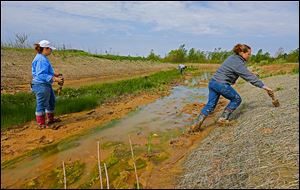
Smith Ditch restoration enters last stage
5/21/2013
Olander Park System conservation team members, including Becky Kanitz, help put in the ground more than 3,000 native plants for Sylvan Prairie Park’s Smith Ditch project.
Three Olander Park employees dug into Smith Ditch’s muddy channel, placing sedges and other water-loving plants in the middle of the stream that runs through Sylvan Prairie Park.
“It’s going to be nice to see what this place looks like in 20 years,” Ian Anderson, part of the Olander Park System conservation team, said.
As part of the conservation team, Mr. Anderson, Maureen Bogdanski, and Becky Kanitz helped plant more than 3,000 native plants such as the burr sedges they were rooting on a recent morning at Sylvan Prairie Park, 8601 Brint Rd.
The beautification effort to seed the area, which began in May, is the last stage of the Smith Ditch restoration project. It is to be done by the end of June.
The project began with construction in October. Park officials expanded the width of the ditch from 6 feet to 30 feet. About 2,400 linear feet of Smith Ditch was restored as part of the plan to redesign the ditch’s stream to meander and form a natural path in the flood plain.
The banks around the channel are bare now, but the work of Olander Park and the numerous volunteers who helped to restore the natural habitat to its original splendor aims to eventually draw animals, as well as residents taking a break to admire its beauty.
“The expansion allows the stream to form its own channel; it increases the capacity for storm water,” said Erika Buri, conservation manager.
Letting the stream create its natural path and riffles makes a flood plain and allows the natural characteristics and ecological integrity of the stream to thrive, she explained.
Widening the ditch will reduce flooding upstream downstream, she said. It also will reduce the sediment load in the stream, which Ms. Buri said will decrease sediment that flows into the Ottawa River and ultimately, Lake Erie.
Part of a stream’s habitat is having aquatic plants and animals, along with trees, whose canopy provides shade and whose roots stabilize the stream’s banks.
The shade aids stream health by keeping it cool, and trees are a good food source for wildlife, Ms. Buri said.
This month, Timberstone Junior High seventh graders volunteered to plant 438 native trees, including musclewood, flowering dogwood, burr oak, red oak, buckeye, and elderberry along the stream’s path.
“We partnered with Olander because they are an organization that most of our students directly benefit from and we wanted to give back,” said Melissa Dubiel, a reading teacher, who helped organize the day.
The project cost $168,000. The Ohio EPA awarded Olander Park a grant of about $101,000 in 2011.
Olander Park covered the remaining $67,000 with $13,000 from its operating budget and $54,000 in kind from staff time, volunteer time, or donated time from the Lucas Soil and Water Conservation District, Ms. Buri said.